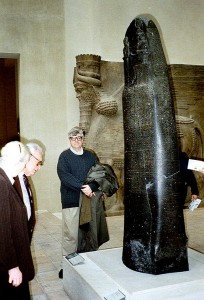Ancient History Sourcebook:
Code of Hammurabi, c. 1780 BCE
-
Commentary by Charles F. Horne, (1915)
-
Commentary by Claude Hermann Walter Johns, The Encyclopaedia Britannica, 11th ed, 1910-
- Text, Translated by L. W. King
Charles F. Horne: The Code of Hammurabi: Introduction
[Hammurabi] was the ruler who chiefly established the greatness of Babylon, the world’s first metropolis. Many relics of Hammurabi’s reign ([1795-1750 BC]) have been preserved, and today we can study this remarkable King….as a wise law-giver in his celebrated code. . .
[B]y far the most remarkable of the Hammurabi records is his code of laws, the earliest-known example of a ruler proclaiming publicly to his people an entire body of laws, arranged in orderly groups, so that all men might read and know what was required of them. The code was carved upon a black stone monument, eight feet high, and clearly intended to be reared in public view. This noted stone was found in the year 1901, not in Babylon, but in a city of the Persian mountains, to which some later conqueror must have carried it in triumph. It begins and ends with addresses to the gods. Even a law code was in those days regarded as a subject for prayer, though the prayers here are chiefly cursings of whoever shall neglect or destroy the law.
The code then regulates in clear and definite strokes the organization of society. The judge who blunders in a law case is to be expelled from his judgeship forever, and heavily fined. The witness who testifies falsely is to be slain. Indeed, all the heavier crimes are made punishable with death. Even if a man builds a house badly, and it falls and kills the owner, the builder is to be slain. If the owner’s son was killed, then the builder’s son is slain. We can see where the Hebrews learned their law of “an eye for an eye.” These grim retaliatory punishments take no note of excuses or explanations, but only of the fact–with one striking exception. An accused person was allowed to cast himself into “the river,” the Euphrates. Apparently the art of swimming was unknown; for if the current bore him to the shore alive he was declared innocent, if he drowned he was guilty. So we learn that faith in the justice of the ruling gods was already firmly, though somewhat childishly, established in the minds of men.
Yet even with this earliest set of laws, as with most things Babylonian, we find ourselves dealing with the end of things rather than the beginnings. Hammurabi’s code was not really the earliest. The preceding sets of laws have disappeared, but we have found several traces of them, and Hammurabi’s own code clearly implies their existence. He is but reorganizing a legal system long established.
